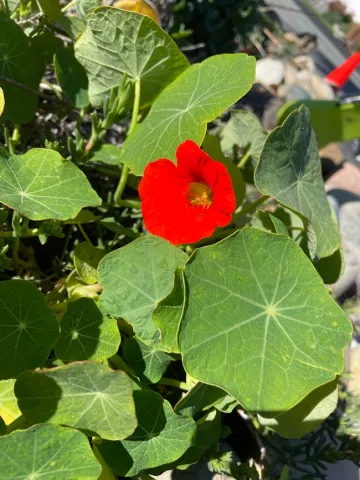
Nasturtium
By Alissa Bright UCCE Master Gardener
Nasturtiums
Tropaeolum majus /Tropaeolum minor
Planting Area: USDA zones 2-11
Size: Parasol leaves grow to 6” in diameter, while majus vines can sprawl up to 20'. Minor stems are more compact and bushy; ideal for pots.
Bloom Season: Spring through Fall
Exposure: Full to partial sun
Pruning needs: The longest trailing vines of Tropaeolum major can be pruned when leggy (6-12”) to stimulate new leaf & flower growth.
Water Needs: Nasturtium prefer ample water and well-drained, sandy soil; though some easy-going species are drought-tolerant.
Snapshot: Even “brown-thumb” gardeners can grow nasturtium; in fact, they often pop up as volunteers in Central Coast gardens. Every garden bed visitor can feast on nasturtium- hummingbirds, bees, and even people! The entire plant, from its cheerful flowers to lily-pad-like leaves to stems to seeds, is edible for humans. Exceptionally sweet nasturtium blooms attract hummingbirds to stop and sip, thanks to a concentrate of sucrose in its nectar.
Nasturtium's wide, rounded, landing-pad leaves invite butterflies to lay their eggs on the undersides. Veggie gardeners can steer pests like the white cabbage butterfly looking to lay eggs in your garden to this sacrificial scapegoat plant and save their cabbages from becoming a pest nursery by inviting nasturtium into their beds. Most plants enjoy nasturtium as a neighbor to attract away aphids.
Plant from seed to enjoy jewel-tone blooms in orange, red or ivory in your garden, as nasturtium doesn't transplant well. Poor soil produces more flowers and pruning spurs on new growth. Adventurous horticulturalists can add nasturtium blooms and leaves to their salad- just be sure to check the undersides for insect eggs first.
We are still here!!!
No in-person workshops for now, but you can view workshops on:
Instagram live at slo_mg or visit our You Tube channel
at “San Luis Obispo County UC Master Gardeners”.
Visit our website; https://ucanr.edu/sites/mgslo/
or email us at anrmgslo@ucanr.edu
Our physical offices are closed, but you can still call or email questions:
San Luis Obispo 805-781-5939
Arroyo Grande 805-473-7190
Templeton 805-434-4105

